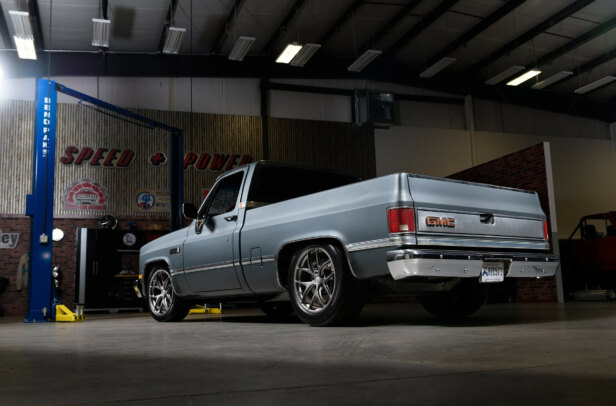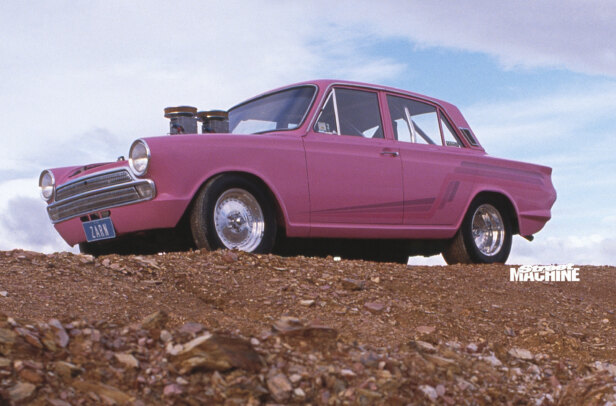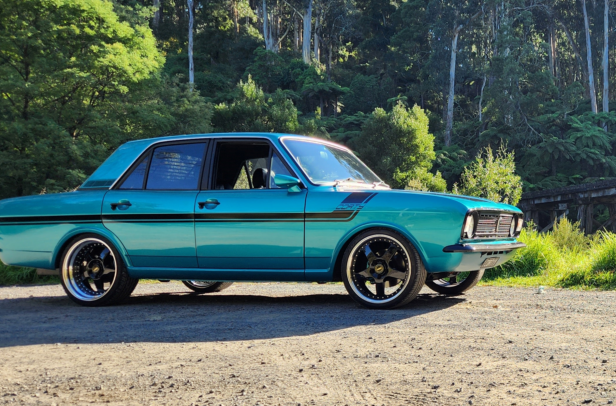SILENCE. That’s what gets you with electric cars. Stomp on the throttle and you’re flung forward at surprising speed, but your senses aren’t properly satisfied. No trace of the familiar suck, squeeze, bang, blow of combustion; no grin-bringing exhaust music as you tickle the redline. When a Tesla whisks by, silence is expected, but what about a 1965 Ford Cortina Mk1 humming along like a spaceship?
Welcome to the world of electro-modding. Gone is this classic Cortina’s traditional 1500cc Kent four-pot; in its place is a 100kW/235Nm electric motor fed by a 31kWh Tesla battery pack giving a driving range of about 180km.
In pubs around the land, beer is spraying from the mouths of the disgusted. Outrage! Sacrilege! Burn the witch! But hang on. What if converting a classic car to electric meant it went from being unused to being a daily driver? Surely that’s a positive. Especially if nothing’s been modified to prevent a petrol motor being dropped back in at some point down the track.
The Cortina’s owner, Brisbane’s Tim Harrison, is not some soulless tech nerd. Quite the opposite. He’s one of us, having previously owned a 1971 Valiant VG hardtop and a 1960 Holden FB wagon. He gets old cars, but is incredibly happy his Cortina’s now electric. “There’s always traditionalists and purists who don’t believe any old car should be touched, and I agree with them to a degree,” he says. “Valuable and rare collectible cars should be maintained for their historical value, but there are a raft-load of classics waiting to be resurrected that otherwise wouldn’t be on the road. These are the ones I want to bring back and be enjoyed.”
So, how’s it all been done? Tim found an unfinished project Mk1 Cortina with a good body but toasted engine. His job as a project manager at Evie – an electric vehicle fast charging network – had turned him on to electro-modding. He’d seen some converted VW Beetles and Morris Minors, so a Cortina EV had appeal. “I really appreciate electric vehicle drivetrains – their efficiency and the thrill of them,” he says. “But I’m not necessarily taken with all the new EVs on the market, so a classic Cortina was a good challenge, as nobody had done one before.”
Appreciating Lotus road and race car history and the fact that the Mk1 Cortina is a lightweight legend thanks to its Lotus association, Tim’s first experiments began. He bought a wrecked 2011 Mitsubishi i-MiEV (a horrible little overpriced electric city car) in the hope he could do a direct electric motor and battery transplant. This was thwarted by “software limitations and modern OEM controls on the ECU and drive unit,” he says.
In the States, electro-modding is already a thriving business, so Tim turned to NetGain in the USA for its off-the-shelf HyPer9 motor and on-board charging and battery management systems. “I then upped the ante and found a written-off 2018 Tesla Model X 100D,” he says. “I salvaged the battery pack to use in the Cortina, but only about one-third of it. Using the full pack would have meant it’d be way too heavy, deteriorating performance, and I’d need to upgrade the suspension.”
Brisbane electric car conversion specialist Traction EV did all the battery work, motor integration and installation, Suzi Auto balanced the driveshaft and totally reconditioned the diff, while Tim “hovered over the top, doing the interface between the displays and the driver interaction pieces.” An Android head-unit screen is a required modern compromise – mounted just above the long-throw manual gear-shifter – and it runs the Torque Pro app, giving a suite of digital gauges to show the likes of power, rpm, regeneration kW, amps, motor temp, battery temp and inverter temp.
Interestingly – and unlike modern electric cars – the Cortina’s four-speed manual gearbox has been retained, although this is a reconditioned Mk2 version upgraded with a high-performance clutch. “You can drive it like a manual or an automatic,” Tim explains. “The electric motor, when it idles, is not spinning, so you can shift to any gear when stationary without using the clutch. When you’re on the go and the motor’s spinning and accelerating, you can shift through the gears just like a normal manual.”
I’ve driven nearly every electric car on today’s market, and practically all are single gear ratio. All the motor’s torque arrives instantly – that’s the fun part – but not having any gears to move through seriously dilutes the driving experience. In Tim’s Cortina, having a clutch to dip and that lovely long-stalk gear shifter to stir feels so much more involving, even if you don’t actually need to do it.
As a bonus, when stuck in city traffic and feeling lazy, you just stick it in third gear and drive it totally clutchless. “It’ll do zero to 100km/h in third gear without touching the clutch, and it’ll never stall, as it’s an electric motor,” Tim said.
Lack of noise aside, it drives very much like a 1960s Cortina. The strawberries-and-cream front bench seat – beautifully restored – means you have to hang on to the giant original steering wheel when cornering. Up front, Ultra Low King Springs coils have been fitted, helping with handling and stance. Original Cortina leaf springs are retained at the back, but are due an upgrade or reset, as they’re a bit compressed due to the weight of the rear battery box. It handles quite sweetly, helped no doubt by a low centre of gravity from those heavy, low-down batteries.
Unlike every modern electric car, this Mk1 Cortina doesn’t feel lardy. Its finished weight is just 1007kg – only 100kg over an original Cortina Mk1, so it pulls away from standstill in an eager, light-footed way. It’ll hit 100km/h in around 7.5 seconds and on to over 130km/h, meaning it’d outrun even the iconic Lotus Cortina of the era, and wipe the floor with the Ford-powered family sedan version.
As for sending some charge back to the battery, there’s a switch just beside the oversized steering wheel to control regenerative braking. You can simply select Hi, Lo or Off depending on your drive. Lift off the throttle and the car feels like it’s braking for you, all the while adding extra driving range. A lovely touch is the repurposing of the Cortina’s original analogue fuel gauge, converted now to display battery capacity.
Also repurposed is the Cortina’s rear-mounted fuel filler. This now has a Type 1 AC socket for home charging, giving zero-to-100 per cent charge in around 10 hours. A public DC fast charger does the job in around 60 minutes, and Tim can bank on a range of around 180km with a full battery.
One of Tim’s goals in undertaking this project was to make this conversion totally reversible. There are no modifications to the Cortina’s original body and no welding or cutting. The only compromise needed was to remove the original fuel tank from under the boot floor (won’t be needing that anyway) in order to house the high-voltage components. It’s a flush job, and it means the boot still has its as-standard capacity.
“I didn’t want it to be compromised as a car,” Tim says. “I needed it to fit luggage, and be safe enough for our two kids. We’ve fitted modern seatbelts and two child seat anchor points.” Imperative for a Queensland summer, a high-voltage compressor runs off the main battery pack to work the electric air conditioning.
Regardless of one’s thoughts on electro-modding classic cars, all should appreciate the quality of work here. And Tim’s keen to change people’s perspectives – even the most hard-nosed purists: “Electrification takes away the reliability issues and maintenance, as servicing is much simpler and easier,” he says. “They’re easier to drive and you can focus on just enjoying them.”
With an electric conversion such as this costing in the region of $30-40,000 it’s certainly not cheap. That said, many spend this and even more on a classic car’s engine and drivetrain rebuild. An electromod should prove far more reliable too – there really are very few moving parts – giving more opportunity to use such cars as daily drivers. It may not make the sound you’d expect from a Mk1 Cortina, but it’s a beautiful sight to see on the roads.
TIM HARRISON
1965 FORD CORTINA MK1
Paint: Custom white
DONK
Type: NetGain HyPer9 three-phase AC electric
Power: 100kW
Battery: 31kWh Tesla
Range: Approximately 180km
Charging: CHAdeMO port; full charge in 60 minutes with DC fast charger
0-100km/h: 7.5sec
Top speed: 130mk/h
Weight: 1007kg
SHIFT
Gearbox: Ford Cortina Mk2 four-speed manual
Diff: Ford Cortina Mk1
BENEATH
Front: King Springs Ultra Low
Rear: Mk1 Cortina leaf springs
Brakes: Mk1 Cortina discs (f), Mk1 Cortina drums (r)
ROLLING STOCK
Rims: Reproduction Lotus 13×7, powdercoated with original hubcaps (f & r)
Rubber: Hankook Kinergy EX 185/70R13 (f & r)
THANKS
James Pauly and Nico Schenk at Traction EV for the conversion; Suzi Auto Services for dialling in the driveline. For more on Tim’s classic electric car projects, visit chargedgarage.com



Comments